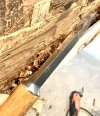I have not used the boat in a couple of years. This fall I spotted cracks in corners of transom cutout. See photos.
I decided to fix immediately to stop further damage. The top edge of the transom was caked with old dried adhesive or sealer that fell away easily. The edge was damp all the way across where the bang plate had been, and its surface dried overnight.
The port side crack was larger and I removed a chunk of fiberglass over the crack. Water had seeped down diagonally toward the drill holes where the swim platform was attached. See dark plywood in cut out fiberglass. Wet, but not dripping or soaked. I banged on the exposed plywood and it is very solid, though damp/wet. There is also de-lamination of the fiberglass layer from the ply in the immediate 6" (+ -) from this corner with a depth of 4-5" down from the top edge. I cannot detect any movement the rest of the way across until I get to the opposite starboard corner. When I the fiberglass it moves slightly.
I have removed several pieces of equipment (more to come) and have not yet seen any moisture down low. All fasteners were originally bedded in a severe amount of sealant. Today, I am going to cut out the scuppers that are in good locations to see if there is moisture below the area of the transom cut out.
Red highlighted area. Propose cutting out rectangular piece, grinding back, insert coosa plate, then grind down forward face of transom in the splash well, fold over layers of glass from outside to inside of splash well.
Top of transom edge is stepped. Why not flush? Why did they just fill it with caulk and call it a day with bang plate? I know cost, but it makes it difficult to smoothly glass over. I appreciate any ideas for attacking this part, as I don't want to change the final shape or dimensions of the finished transom.
I wrote the post this morning and didn't send. Has anyone removed the outer face of the transom to access water damage? So far I don't see evidence of the transom being waterlogged and if exposed it would dry. It's ideal humidity levels right now and I could reglass and add back the external skin. If I find its more damaged than I expect, well then the skin is off and its one step closer to replacement. I have no plan to do any replacement from the inside. I would have to tear down too much of the deck, jump seats/ battery box, oil and trim pump box, transom splash well and the the whole aft section of the gunnel cap, just to get access to the inner skin of the transom. thanks
Port corner starboard corner

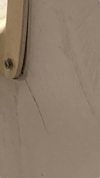
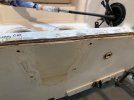
Port side where fiberglass separated, plywood peeled by FG still adhered
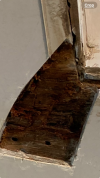
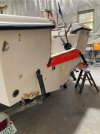
I decided to fix immediately to stop further damage. The top edge of the transom was caked with old dried adhesive or sealer that fell away easily. The edge was damp all the way across where the bang plate had been, and its surface dried overnight.
The port side crack was larger and I removed a chunk of fiberglass over the crack. Water had seeped down diagonally toward the drill holes where the swim platform was attached. See dark plywood in cut out fiberglass. Wet, but not dripping or soaked. I banged on the exposed plywood and it is very solid, though damp/wet. There is also de-lamination of the fiberglass layer from the ply in the immediate 6" (+ -) from this corner with a depth of 4-5" down from the top edge. I cannot detect any movement the rest of the way across until I get to the opposite starboard corner. When I the fiberglass it moves slightly.
I have removed several pieces of equipment (more to come) and have not yet seen any moisture down low. All fasteners were originally bedded in a severe amount of sealant. Today, I am going to cut out the scuppers that are in good locations to see if there is moisture below the area of the transom cut out.
Red highlighted area. Propose cutting out rectangular piece, grinding back, insert coosa plate, then grind down forward face of transom in the splash well, fold over layers of glass from outside to inside of splash well.
Top of transom edge is stepped. Why not flush? Why did they just fill it with caulk and call it a day with bang plate? I know cost, but it makes it difficult to smoothly glass over. I appreciate any ideas for attacking this part, as I don't want to change the final shape or dimensions of the finished transom.
I wrote the post this morning and didn't send. Has anyone removed the outer face of the transom to access water damage? So far I don't see evidence of the transom being waterlogged and if exposed it would dry. It's ideal humidity levels right now and I could reglass and add back the external skin. If I find its more damaged than I expect, well then the skin is off and its one step closer to replacement. I have no plan to do any replacement from the inside. I would have to tear down too much of the deck, jump seats/ battery box, oil and trim pump box, transom splash well and the the whole aft section of the gunnel cap, just to get access to the inner skin of the transom. thanks
Port corner starboard corner



Port side where fiberglass separated, plywood peeled by FG still adhered




